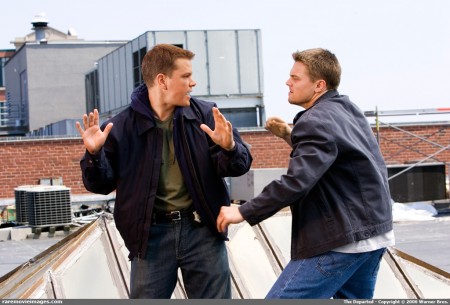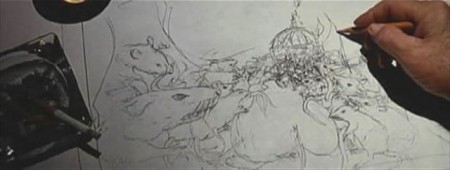Strange Moments in Solid Movies: You Dirty Rat, The Departed
Martin Scorsese is no stranger to gangster films populated by many dishonorable characters in seedy locations, scurrying around in the dark, power-playing for any (and all) loose change and on the even looser morality of their depraved circles. Starting with 1973’s Mean Streets and later reworking the turf in the 1990s with Goodfellas and Casino, Scorsese’s examinations into the gangster lifestyle have no doubt been artistically fruitful for him, as he has been better able–or, perhaps more appropriately, more willing–to show the brutal realities perpetuated by members of the underworld. And yet, in this place of double crosses and deceptions (all for the intention of looking out for number one), as outlandish as it seems, a certain code of “noble” behavior becomes hopelessly entangled in the proceedings: that, at the very least, disreputable people ought to have the common decency to live up to that reliable classification and not turn out to be backstabbers–rats–working against fellow low lives. It’s a fascinating quandary, both absurd and unsettling to behold, and it’s one that Scorsese brings to the forefront in his (only) Oscar-winning film The Departed.
An overhaul of 2002’s Hong Kong crime-drama Infernal Affairs, The Departed relocates to the mean streets of Boston, where a special brand of criminal behavior in the resident Irish Catholics is the predominant spice of life for the devout (as opposed to the original’s Buddhist tendencies). But, like many appearances in the film, such outward conduct is oftentimes brandished by some to throw others off their own odious scent–and church incense can only get you so far. This incongruity, between belief and behavior, goes for both gangsters who are chased by the police as well as the bought cops who are spied on by Internal Affairs and the FBI (to name just a few watchers of the supposed watchmen). And the only people who are inexhaustibly true to themselves are the faithfully departed, dead and gone from the sinking world and fading in the memories of the scheming men who lose themselves in the rampant climb out against the submergence.
The Departed works best when it reveals how the Boston underworld and the people who exist therein are endlessly malleable, bending to many wills (which raises the question: how could anyone be truly surprised when someone else turns out to be a rat?). And the supreme author of this vicious social strata is criminal mastermind Frank Costello (Jack Nicholson), and he knows it: “I don’t want to be a product of my environment; I want my environment to be a product of me.” Operating within this shifting climate (and ostensibly under Costello’s thumb), the audience follows two prevailing informers in the narrative: Billy Costigan (Leonardo DiCaprio), undercover cop who becomes Costello’s go-to guy, and Colin Sullivan (Matt Damon), Costello’s informer in Internal Affairs who goes rogue for himself. With both characters working on opposite sides of the law (even simultaneously for and against those forces which they are expected to undermine), the film develops into a psychological game of cat and mouse, with no clear-cut cat to be found throughout and a whole host of rats laying siege to the city.
Now we come to the strange moment in The Departed. For the most part, up until its final frames, the film is relatively consistent in its tone and themes (even though what precedes this conclusion stresses a world in flux). Because of the wheeling and dealing, Scorsese’s trademark dark humor is wonderfully employed as each rat is pitted against others, each treacherous character faces sudden turns of events on the way to a cruel fate. But then there is the ending, which takes that tonal and thematic consistency and recapitulates it by literalization–by making the rat come alive. Take a look for yourself (and spoiler warning if you haven’t seen it):
The transition from figurative rat (ie. an informer) to a literal one at the end is a touch jarring and self-defeating in the way that the figurative rat is what the movie is all about. Finding out who the “rats” are and seeing how their actions plays out is part of the fun. Deception and double-crossing can occur because the characters appear to be one thing and end up being something else. But when we enter the realm of the literal, it becomes far more concrete, obvious. Sure, the rat may “mean” something, adding a nice bow on the movie, that says, “here is your final meaningful image”. And yes, it is also a shot that recalls an earlier one in the film in Costello’s drawing (seen above), so it does work off that notion (one that I think would have perhaps been more powerfully conveyed if it had stood by itself, without a curtain call). But the moment ultimately does not contribute anything too substantial, except revealing a darkly comic twist: a real rat manages to ascend way up into a cushy apartment overlooking the Capitol Building, with its golden dome glistening in the sunshine on a beautiful day–a serene fate, as it turns out, that is much better than Sullivan’s bloody end because of his wretched duplicity. We know that the (figurative) rats have risen up to a higher-class area already; we have seen such promotions play out for the last two hours. Likewise, we have seen those rats meet similarly violent deaths, without the need of a real rat to show up for juxtapositional purposes. So, although it may work on a comic level (and for that I appreciate it), the literal and callbacking rat comes across as being too thematically precise and fatalistic. And by my calculation, that’s one rat step too far.





